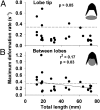Stealth predation and the predatory success of the invasive ctenophore Mnemiopsis leidyi
- PMID: 20855619
- PMCID: PMC2951412
- DOI: 10.1073/pnas.1003170107
Stealth predation and the predatory success of the invasive ctenophore Mnemiopsis leidyi
Abstract
In contrast to higher metazoans such as copepods and fish, ctenophores are a basal metazoan lineage possessing a relatively narrow set of sensory-motor capabilities. Yet lobate ctenophores can capture prey at rates comparable to sophisticated predatory copepods and fish, and they are capable of altering the composition of coastal planktonic communities. Here, we demonstrate that the predatory success of the lobate ctenophore Mnemiopsis leidyi lies in its use of cilia to generate a feeding current that continuously entrains large volumes of fluid, yet is virtually undetectable to its prey. This form of stealth predation enables M. leidyi to feed as a generalist predator capturing prey, including microplankton (approximately 50 μm), copepods (approximately 1 mm), and fish larvae (>3 mm). The efficacy and versatility of this stealth feeding mechanism has enabled M. leidyi to be notoriously destructive as a predator and successful as an invasive species.
Conflict of interest statement
The authors declare no conflict of interest.
Figures





References
-
- Vinogradov ME, Shushkina EA, Musaeva EI, Sorokin P. New settler in the Black Sea—comb jelly Mnemiopsis leidyi (Agassiz) Okeanologiya. 1989;29:293–299.
-
- Studenikina EI, Volovik SR, Mirzoyan ZA, Luts GI. Comb jelly Mnemiopsis leidyi in the Azov Sea. Okeanologiya. 1991;31:722–725.
-
- Shiganova TA, et al. Population development of the invader ctenophore Mnemiopsis leidyi in the Black Sea and in other seas of the Mediterranean basin. Mar Biol. 2001;139:431–445.
-
- Shiganova TA, Malej A. Native and non-native ctenophores in the Gulf of Trieste, Northern Adriatic Sea. J Plankton Res. 2009;31:61–71.
-
- Javidpour J, Sommer U, Shiganova TA. First record of Mnemiopsis leidyi A. Agassiz 1865 in the Baltic Sea. Aquatic Invasions. 2006;1:299–302.
Publication types
MeSH terms
LinkOut - more resources
Full Text Sources

